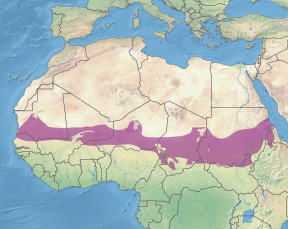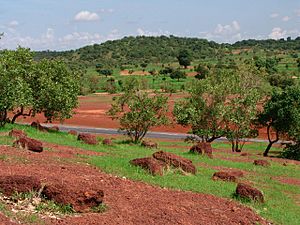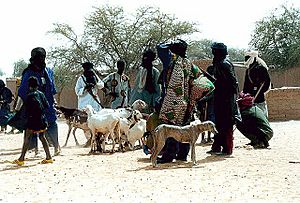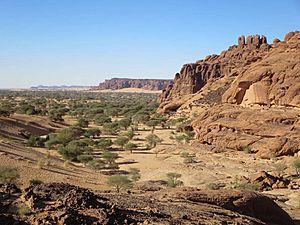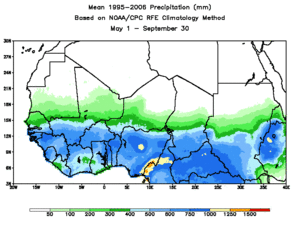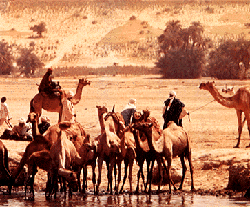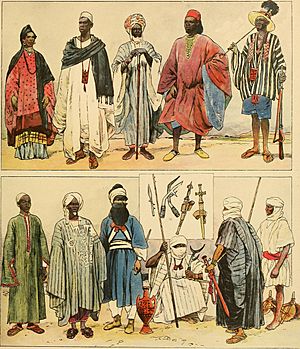Sahel facts for kids
Quick facts for kids Sahel |
|
|---|---|
|
Throughout the Sahel, rammed earth construction is widespread, as exemplified by this medieval mosque in Burkina Faso
|
|
|
The Sahel region in Africa: a belt up to 1,000 km (620 mi) wide that spans 5,400 km (3,360 mi) from the Atlantic Ocean to the Red Sea
|
|
| Ecology | |
| Realm | Afrotropical |
| Biome | Tropical and subtropical grasslands, savannas, and shrublands |
| Borders |
List
|
| Animals | Camels, horses |
| Bird species | Migratory birds |
| Mammal species | Oryx, Gazelles, African buffalo |
| Geography | |
| Area | 3,053,200 km2 (1,178,800 sq mi) |
| Countries | |
| Elevation | 200 and 400 meters (660 and 1,310 ft) |
| Rivers | Senegal, Niger, Nile |
| Climate type | Tropical savanna climates (Aw), Hot Semi-arid (BSh), Hot Desert (BWh) |
The Sahel region, or Sahelian acacia savanna, is a biogeographical region in Africa. It is the transition zone between the more humid Sudanian savannas to its south and the drier Sahara to the north. The Sahel has a hot semi-arid climate and stretches across the southernmost latitudes of North Africa between the Atlantic Ocean and the Red Sea. Although geographically located in the tropics, the Sahel does not have a tropical climate.
Especially in the western Sahel, there are frequent shortages of food and water due to its very high government corruption and the semi-arid climate. This is exacerbated by very high birthrates across the region, resulting in a rapid increase in population. In recent times, various coups, insurgencies, terrorism and foreign interventions have taken place in many Sahel countries, especially across former Françafrique.
Contents
Geography
The Sahel spans 5,900 km (3,670 mi) from the Atlantic Ocean in the west to the Red Sea in the east, in a belt several hundred to a thousand kilometers (c. 600 miles) wide. It covers an area of 3,053,200 square kilometers (1,178,850 sq mi).
Representing a climatic and ecological transition zone with hot semi-desert and steppe conditions, the Sahel region borders the more humid Sudanian savannas to its south and the dry Sahara desert to the north. This ecoregion is also called the Sahelian Acacia savanna in honour of its most prominent and very drought tolerant genus of tree.
The topography of the Sahel is mainly flat; most of the region lies between 200 and 400 meters (660 and 1,310 ft) in elevation. Several isolated plateaus and mountain ranges rise from the Sahel (e.g. Marrah Mountains, Aïr Mountains, Ennedi Plateau), but are designated as separate ecoregions because their flora and fauna are distinct from the surrounding lowlands (e.g. East Saharan woodlands). Annual rainfall varies from around 100–200 mm (4–8 in) in the north of the Sahel to around 700–1,000 mm (28–39 in) in the south.
Flora and fauna
The Sahel is mostly covered in grassland and savanna, with areas of woodland and shrubland. Grass cover is fairly continuous across the region, dominated by annual grass species such as Cenchrus biflorus, Schoenefeldia gracilis and Aristida stipoides. Species of acacia are the dominant trees, with Acacia tortilis the most common, along with Senegalia senegal and Senegalia laeta. Other tree species include Adansonia digitata, Commiphora africana, Balanites aegyptiaca, Faidherbia albida, Borassus aethiopum, Vitellaria paradoxa, Olea europaea, Arbutus unedo, Phoenix canariensis, Phoenix dactylifera, Hyphaene compressa, Cupressus sempervirens, Quercus coccifera, Quercus suber, Quercus ilex, Quercus pubescens, Pistacia terebinthus, Pinus nigra, Populus alba, Populus nigra, Ceratonia siliqua, Salix alba, Afzelia africana, Kigelia africana, Sclerocarya birrea, Ziziphus spina-christi, Ficus salicifolia, Juglans regia, Laurus nobilis, Vachellia flava, Prosopis cineraria, Pinus halepensis, Aerva javanica, Prunus amygdalus, Corylus avellana, Juniperus communis, and Boscia senegalensis. In the northern part of the Sahel, areas of desert shrub, including Panicum turgidum and Aristida sieberiana, alternate with areas of grassland and savanna. During the long dry season, many trees lose their leaves and the predominantly annual grasses die.
The Sahel was formerly home to large populations of grazing mammals, including the scimitar-horned oryx (Oryx dammah), dama gazelle (Gazella dama), Dorcas gazelle (Gazella dorcas), red-fronted gazelle (Gazella rufifrons), the giant prehistoric buffalo (Pelorovis), and Bubal hartebeest (Alcelaphus buselaphus buselaphus), along with large predators, such as the African wild dog (Lycaon pictus), the Northwest African cheetah (Acinonyx jubatus hecki), the Northeast African cheetah (Acinonyx jubatus soemmeringii), and the lion (Panthera leo). The larger species have been greatly reduced in number by over-hunting and competition with livestock, and several species are vulnerable (Dorcas gazelle, cheetah, lion and red-fronted gazelle), endangered (Dama gazelle and African wild dog), or extinct (the Scimitar-horned oryx is probably extinct in the wild, and both Pelorovis and the Bubal hartebeest are now extinct).
The seasonal wetlands of the Sahel are important for migratory birds moving within Africa and on the African-Eurasian flyways.
Climate
The Sahel has a hot semi-arid climate (Köppen climate classification BSh). The climate is typically hot, sunny, dry and somewhat windy all year long. The Sahel's climate is similar to, but less extreme than, the climate of the Sahara desert located just to the north.
The Sahel mainly receives a low to very low amount of precipitation annually. The steppe has a very long, prevailing dry season and a short rainy season. The precipitation is also extremely irregular, and varies considerably from season to season. Most of the rain usually falls during four to six months in the middle of the year, while the other months may remain absolutely dry. The interior of the Sahel region generally receives between 200 mm and 700 mm of rain yearly. A system of subdivisions often adopted for the Sahelian climate based on annual rainfall is as follows: the Saharan-Sahelian climate, with mean annual precipitation between around 100 and 200 mm (such as Khartoum, Sudan), the strict Sahelian climate, with mean annual precipitation between around 200 and 700 mm (such as Niamey, Niger) and the Sahelian-Sudanese climate, with mean annual precipitation between around 700 and 900 mm (such as Ouagadougou, Burkina Faso). The relative humidity in the steppe is low to very low, often between 10% and 25% during the dry season and between 25% and 75% during the rainy season. The least humid places have a relative humidity under 35%.
The Sahel is characterized by constant, intense heat, with an unvarying temperature. The Sahel rarely experiences cold temperatures. During the hottest period, the average high temperatures are generally between 36 and 42 °C (97 and 108 °F) (and even more in the hottest regions), often for more than three months, while the average low temperatures are around 25 to 31 °C (77 to 88 °F). During the "coldest period", the average high temperatures are between 27 and 33 °C (81 and 91 °F) and the average low temperatures are between 15 and 21 °C (59 and 70 °F). Everywhere in the Sahel, the average mean temperature is over 18 °C (64 °F).
The Sahel has a high to very high sunshine duration year-round, between 2,400 hours (about 55% of the daylight hours) and 3,600 hours (more than 80% of the daylight hours). The sunshine duration in the Sahel approaches desert levels, and is comparable to that in the Arabian Desert, for example, even though the Sahel is only a steppe and not a desert. The cloud cover is low to very low. For example, Niamey, Niger has 3,082 hours of bright sunshine; Gao, Mali has near 3,385 hours of sunshine; Timbuktu, Mali has 3,409 sunny hours, and N'Djamena, Chad has 3,205 hours of sunlight.
Recent droughts
For hundreds of years, the Sahel region has experienced frequent droughts and megadroughts. One megadrought lasted from 1450 to 1700, 250 years. There was a major drought in the Sahel in 1914 caused by annual rains far below average, leading to large-scale famine. From 1951 to 2004, the Sahel experienced some of the most consistent and severe droughts in Africa. The 1960s saw a large increase in rainfall in the region, making the northern drier region more accessible. There was a push, supported by governments, for people to move northwards. When the long drought period from 1968 through 1974 began, grazing quickly became unsustainable and large-scale denuding of the terrain followed. Like the drought in 1914, this led to a large-scale famine, but this time somewhat tempered by international visibility and an outpouring of aid. This catastrophe led to the founding of the International Fund for Agricultural Development.
2010 drought
Between June and August 2010, famine struck the Sahel. Niger's crops failed to mature in the heat, 350,000 faced starvation, and 1,200,000 were at risk of famine. In Chad the temperature reached 47.6 °C (117.7 °F) on 22 June in Faya-Largeau, breaking a record set in 1961 at the same location. Niger tied its highest temperature record set in 1998, also on 22 June, at 47.1 °C in Bilma. That record was broken the next day, when Bilma hit 48.2 °C (118.8 °F). The hottest temperature recorded in Sudan was reached on 25 June, at 49.6 °C (121.3 °F) in Dongola, breaking a record set in 1987. Niger reported on 14 July that diarrhoea, starvation, gastroenteritis, malnutrition and respiratory diseases had sickened or killed many children. The new military junta appealed for international food aid and took serious steps to call on overseas help. On 26 July, the heat reached near-record levels over Chad and Niger, and in northern Niger about 20 people reportedly died of dehydration by 27 July.
Desertification and soil loss
The Sahel region faces environmental issues that are contributing to global warming. If the change in climate in the Sahel region "is not slowed-down and desertification possibly reversed through sustainable practices and any form of reforestation, it is only a matter of time before countries like Niger lose their entire landmass to desert due to unchecked unsustainable human practices. Over-farming, over-grazing, over-population of marginal lands, and natural soil erosion, have caused serious desertification of the region. This has affected shelter construction, making it necessary to change the used materials. The Woodless Construction project was introduced in Sahel in 1980 by the Development Workshop, achieving since then a high social impact in the region. A major initiative to combat desertification in the Sahel region via reforestation and other interventions is the Great Green Wall.
Major dust storms are a frequent occurrence as well. During November 2004, a number of major dust storms hit Chad, originating in the Bodélé Depression. This is a common area for dust storms, occurring on average on 100 days every year.
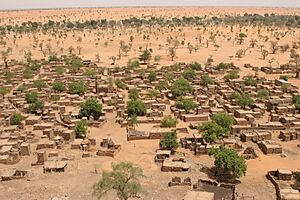
On 23 March 2010, a major sandstorm hit Mauritania, Senegal, The Gambia, Guinea-Bissau, Guinea, and inland Sierra Leone. Another struck in southern Algeria, inland Mauritania, Mali and northern Ivory Coast at the same time.
Following the drought period of the 1970s and 1980, however, the Sahel began to experience increased rainfall. This may be due to global warming, which can cause changes that may result in changes in large-scale weather patterns, such as increased stronger monsoons, in turn caused by a warmer Atlantic Ocean. Warming of the Mediterranean Sea may also be a factor.
Protected areas
Protected areas in the Sahel include Ferlo Nord Wildlife Reserve in Senegal, Sylvo-Pastoral and Partial Faunal Reserve of the Sahel in Burkina Faso, Ansonga-Ménake Faunal Reserve in Mali, Tadres Reserve in Niger, and Waza National Park in Cameroon.
Culture
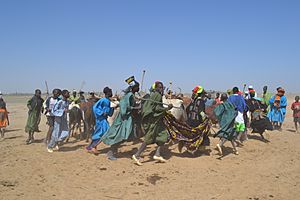
Traditionally, most of the people in the Sahel have been semi-nomads, farming and raising livestock in a system of transhumance. The difference between the dry North with higher levels of soil nutrients and the wetter South with more vegetation, is utilized by having the herds graze on high-quality feed in the North during the wet season, and trek several hundred kilometers to the South to graze on more abundant, but less nutritious feed during the dry period.
In Western Sahel, polygamy and child marriage are common.
Etymology
The term "Sahel" is borrowed from the Arabic name for the region, الساحل al-sāḥil. Sāḥil literally means "coast, shore", which has been explained as a figurative reference to the southern edge of the vast Sahara. However, such use is unattested in Classical Arabic, and it has been suggested that the word may originally have been derived from the Arabic word سهل sahl "plain" instead.
History
Early agriculture
Around 4000 BC, the climate of the Sahara and the Sahel started to become drier at an exceedingly fast pace. This climate change caused lakes and rivers to shrink significantly and caused increasing desertification. This, in turn, decreased the amount of land conducive to settlements and caused migrations of farming communities to the more humid climate of West Africa.
Sahelian kingdoms
The Sahelian kingdoms were a series of monarchies centered in the Sahel between the 9th and 18th centuries. The wealth of the states, like the legendary Mali Empire at the time of Mansa Musa, came from controlling the trans-Saharan trade routes across the desert, especially with the Maghreb. Their power came from having large pack animals like camels and horses that were fast enough to keep a large empire under central control and were also useful in battle. All of these empires were quite decentralized with member cities having a great deal of autonomy.
The larger Sahelian kingdoms emerged from 750 AD and erected several large cities in the Niger valley region, including Timbuktu, Gao and Djenné.
Due to the wooded areas to their south, the Sahelian states were hindered from expanding into the north Akan state of the Bonoman and Yoruba peoples, as mounted warriors were all but useless in the forests. In addition, the horses and camels were susceptible to the humidity and diseases of the tropics.
Colonial period
The Western Sahel fell to France in the late 19th century as part of French West Africa. Chad was added in 1900 as part of French Equatorial Africa. The French territories in the Sahel were decolonized in 1960.
The Sahel's easternmost region did not fall to the European powers but to the Khedivate of Egypt when it was conquered by Muhammad Ali in the 1820s. By 1899 it came under British rule until granted independence at Egypt's behest in 1956.
See also
 In Spanish: Sahel para niños
In Spanish: Sahel para niños
- Community of Sahel-Saharan States
- Epidemiology of Meningitis
- Green Sahara
- Great Green Wall
- 2010 Sahel famine
- 2012 Sahel drought
- Sahel drought
- Sudan (region)
- Sudanian savanna
- Pan Sahel Initiative
- Sahara Conservation Fund
- Semi-arid climate
- Trans-Sahelian Highway
- Maghreb
- Haboob
- Rainwater harvesting in the Sahel
- Desertification in Africa




